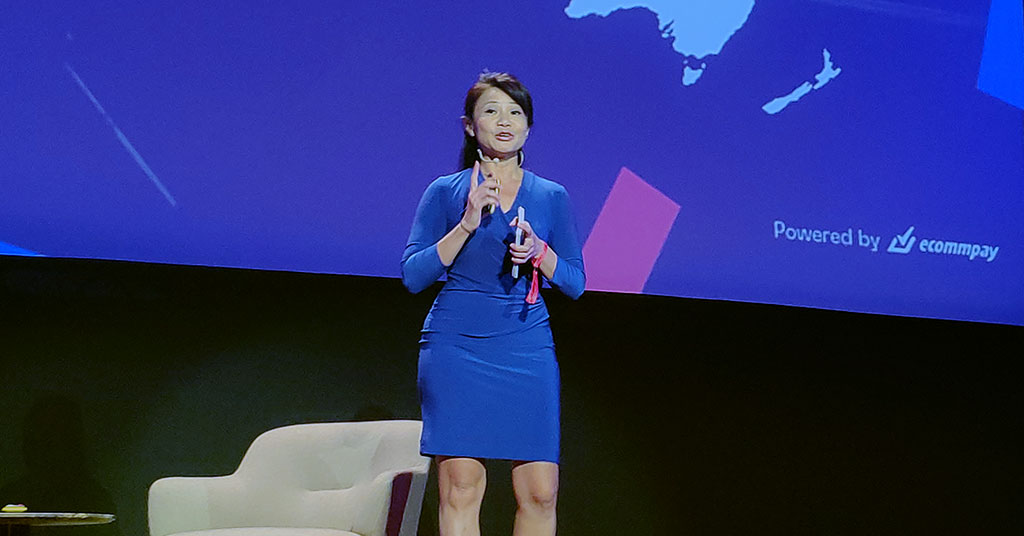Find out what speakers were talking about today at ECOMMTALKS 2019

ECOMMTALKS 2019: experts’ thoughts on fintech drivers and barriers. Source: ecommtalks.com
Today, on November 14, the payment company ECOMMPAY organized a closed fintech conference ECOMMTALKS 2019 in Riga, Latvia, gathering internal and external experts to discuss what trends we will probably be facing in the nearest future in terms of technological development and payment landscape in Europe and worldwide.
PaySpace Magazine has been invited to visit ECOMMTALKS 2019, and now we are ready to share the latest industry insights delivered from its stage with you.
AI: adoption, benefits, and trends

Romans Taranovs, Head of Analytics & Information Management, Deloitte. Source: payspacemagazine.com
Talking about the adoption of Artificial Intelligence (AI), Romans Taranovs said we can see it happening quite fast. He divided the adoption process into three levels:
- Assisted Intelligence – humans comprehend data and generate insight;
- Augmented Intelligence – machine learning augments human decisions;
- Autonomous Intelligence – AI decides and executes autonomously.
The speaker said this is how it worked with Deloitte’s Analytics tool, which started with people using the reports to generate insights. Currently, the tool is at the second level, with people benefiting from using AI, while controlling and deciding how they can utilize the insights it provides.
Romans Taranovs notes that Latvians, as well as Russians, translate the term “Artificial Intelligence” in a wrong way, confusing it with the term “Intellect”. He highlights that intelligence means that a system is able to adapt to changing circumstances of the environment.
Many companies do experience the benefits of AI. The survey shows which aspects of utilizing this technology companies consider to be the most beneficial:
- enhancement of current products – 44%;
- optimization of internal operations – 42%;
- better decision-making – 35%;
- optimization of external operations – 31%;
- the ability to free human resources for more creative tasks – 31%.
Another important trend which derives from combining human-centered design techniques with leading-edge technologies is Intelligent Interface. New interfaces are moving from keyboards to touchscreens and voice commands, transforming the way we engage with machines, data and each other.
In the next 5 years, according to the expert, the AI will continue to gain traction, along with other cutting-edge technologies, like blockchain and smart contracts.
The diversity of APAC markets

Audrey Ottevanger, Head of Asia Pacific, ECOMMPAY. Source: payspacemagazine.com
The APAC region consists of 48 countries with 4.5 billion people, with each of the markets having its specificities in terms of how the e-commerce and payment industry are developing. In her speech, Audrey Ottevanger focused on the fastest-growing e-commerce markets in East Asia (China, Hong Kong, Japan) and Southeast Asia (Singapore, Malasia, Indonesia, Philippines, Thailand, Vietnam).
The speaker highlights that having only one global strategy won’t be enough for a business to conquer Asia. Although there are some common trends that can be seen in most Asian markets (like the fast-growing middle class, the rise of e-commerce, high smartphone usage, etc.), each country evolves in its own way and pace. And the more developed the market is, the greater the competition. That’s why Audrey Ottevanger suggests companies willing to enter the Asian region to start with choosing and focusing on 2-3 key markets that have much in common.
Another important issue to consider is the cultural sensitivities. For example, Asians don’t say “No” in the meetings, but it doesn’t mean they agree with you, they just don’t want to lose face. In the East, it is just believed to be impolite, in contrast to Western economies, where being brutally honest is appreciated.
When it comes to localization of your service, it is highly needed on almost every Asian market, except for Singapore, Malasia, Philippines, and Hong Kong, where English is quite widespread.
The essential issue is also tackling compliance, local laws, taxation, and regulation, which also differs greatly across the region. For instance, the expert mentioned Malasia and Indonesia as two markets having quite strict financial regulation. Moreover, consumers from different Asian markets have different payment preferences. To deal with it, Audrey Ottevanger recommends considering the set of payment solutions separately for each market. Bank transfers are popular in Thailand, Vietnam, and the Philippines; while credit cards are extremely popular in Singapore, Malasia, and Hong Kong, but for the rest of the countries penetration is pretty low. However, the fastest-growing payment method in Asia is digital wallets.
Tackling global expansion

Panel discussion. Source: ecommtalks.com
The “Tackling global expansion” discussion panel, moderated by Paul Marcantonio, Head of UK and Western Europe, ECOMMPAY, involved Audrey Ottevanger, Head of Asia Pacific, ECOMMPAY, Craig James, CEO, NeoPay, and Richard Harrison, VP Global Partner, PPRO. Experts shared their experience on how to develop and implement a viable expansion strategy. The key recommendations and insights were the following:
- Find out as much as possible about the market you are willing to enter. Will you have to deal with a lot of competitors? Will you be able to offer local customers something value-added, something more than what they already have? Can you afford the expansion and all the related expenses?
- Take a pause and consider all the risks. Examine the pros and cons of the expansion properly, do some preparation. Learn about consumer preferences, cultural specificities, regulations, taxation, licensing, etc. Localize your global strategy for every market you consider.
- Gamification of payments integrates into our lives extremely fast. On the developed markets, where adoption had already taken place, the top goal for businesses is to engage customers, which is what gamification does. This trend stands out globally, especially in Asia.
- Bank cards won’t go anywhere for at least the next 50 years. Even modern payment options, like Google Pay or Apple Pay, still rely on cards. Moreover, there is still a place for innovations in the card business, with biometric cards beeing developed and card companies expanding their range of services.
- China is a very exciting market for newcomers, but it is not easy to enter. Audrey Ottevanger said that Chinese consumers got used to using local services and buying local products, which makes it difficult for foreign companies to win their way up and attract clients. The competition is really tough in China, and the market is huge and diverse, so it can be quite helpful to find a partner who knows it better than you.
SEE ALSO:









